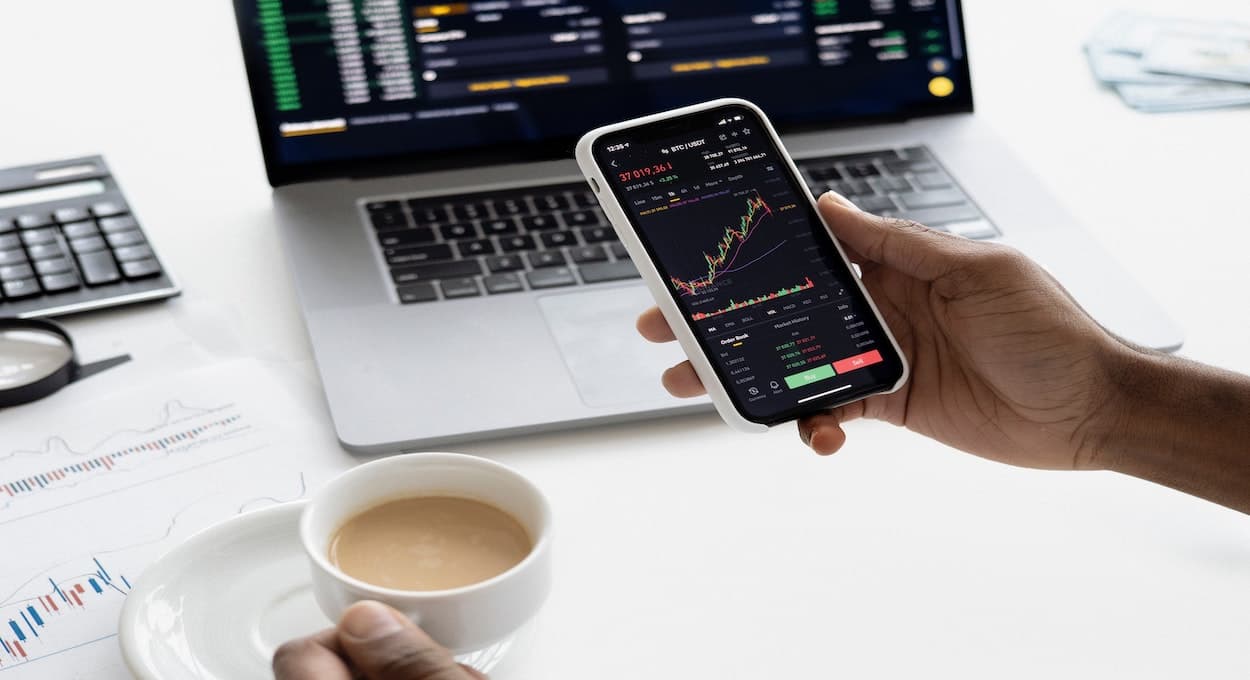What Makes A Stock Go Up & Down? Understanding Market Volatility & Investor Emotions
Having a solid understanding of the stock market can often feel out of reach. Sometimes it follows a predictable pattern and seems to make sense. Meanwhile other times it's volatile for no apparent reason.
Both are true!
Over the long term, the stock market will usually follow regular patterns, and in the short term, there's more market volatility.
A lot of people simply look at the short term, though, and only see large market fluctuations, which is why they associate investing in stocks with risk.
This doesn't have to be the case! When you understand what makes a stock go up and down, learn to control your own emotions when they do, and act using the Rule #1 principles, you can invest confidently, without worrying about what the market will do tomorrow.
So, what causes stock market fluctuations? And, perhaps more timely, why is the stock market going down?
There are many factors that affect the market and can cause a stock market crash or more minor market volatility. We're going to dive into a few of those factors below and hone in on the one you should really be aware of emotions.
How to Pick Rule #1 Stocks
5 simple steps to find, evaluate, and invest in wonderful companies.
How The Stock Market Works
Let's first get into what the stock market is and how it works. Because once you understand how the market works, it will help you be a smarter, more successful investor.
The stock market is a vast network of economic transactions where buyers and sellers trade shares of public companies—which are stocks—with one another. These transactions contribute to the overall market capitalization of companies. It also influences the performance of the broader market index.
The price of a stock is determined by how many buyers vs. sellers there are of that stock at any given moment. That’s supply and demand 101. For a particular stock, these ups and downs can seem random, but there are always underlying reasons for each market price movement. The key is learning to dig into the business so you know what actually drives value, not just what the crowd is doing.
There are plenty of other factors that influence the supply and demand of a stock. These include events, which typically lead to stock market crashes, economic factors such as the rise or fall of interest rates, and investor expectations and emotions.
Let's cover all of these in more detail…
What Causes Stocks to Go Up & Down
If you're wondering why the stock market is going down, look at these key indicators. A few of these factors are to blame for why stocks are going down right now.
Supply & Demand
As I mentioned above, the price of a stock is influenced by how many buyers there are of that stock at any given time (the demand) vs how many sellers there are (the supply).
If a lot of people are selling and not that many people are buying, the price of the stock will drop.
If, on the other hand, there are a lot of people wanting to buy and not a lot of people willing to sell, the price of the stock will rise. At the most basic level, this is how stock prices change.
Future Expectations & Events
The stock market is always looking forward to what might happen in the future — it's almost never looking at what's currently happening.
The stock market is rarely focused on what’s happening right now—it’s always trying to price in what’s coming next.
As investors, that means we’re paying attention to current and future events, and asking: how will this affect the businesses we own or want to own? That’s how you decide whether it makes sense to buy, hold, or sell.
It’s also why headlines can move stock prices so fast. Think back to March 2020—COVID-19 hadn’t shut down the economy yet, but the market saw what was coming. Prices dropped hard across the board, not because businesses had already taken the hit, but because everyone knew the impact was right around the corner.
Other examples of events that make stocks go up and down are natural disasters, wars, and other conflicts between nations, changes in trade policies, elections, etc.
Fluctuating Interest Rates
Rising interest rates and the expectation of rising interest rates may also be the answer to why the stock market is going down. When the Federal Reserve raises interest rates, banks tend to follow suit, which makes it more expensive to borrow money.
How to Pick Rule #1 Stocks
5 simple steps to find, evaluate, and invest in wonderful companies.
When it's more expensive to borrow, everyone—both companies and consumers—tends to spend less. Less spending typically means less growth, and less growth can mean companies aren't increasing their value to warrant higher stock prices.
Here are other key factors that influence stock prices:
Institutional Investors:
Big players like mutual funds and pension funds can create significant price movements when they buy or sell large-cap stocks.
Market Sentiment:
Sometimes, the mood of the market—optimistic or fearful—can send stocks soaring or tumbling, even if the company’s fundamentals haven’t changed.
Company’s Earnings:
Investors tend to pay close attention to how much a company earns. Strong current earnings or the promise of higher future earnings often push share prices higher.
Market Volatility: Why Prices Swing
Let’s talk about volatility—a word that can make even seasoned investors a bit uneasy.
Volatility is simply a statistical measure of how much a stock’s price changes over time. Higher volatility means bigger price swings. Low volatility suggests steadier prices. In an efficient market, these swings reflect all available information, but emotions and speculation can still have a big impact.
You might hear terms like “annualized volatility,” “implied volatility,” or “historical prices.” These are just ways to measure how bumpy the ride has been, or how bumpy investors expect it to be. The CBOE Volatility Index (sometimes called the “VIX” or “fear index”) is a popular tool for tracking expected market volatility. When the VIX spikes, it’s a sign that Wall Street expects choppier waters ahead. This index is considered an underlying index for many volatility-related products and options trading strategies.
How Investor Emotions Cause Stock Market Volatility (Meet "Mr. Market")
The biggest factor that influences fluctuations in the stock market is the emotions of investors and the decisions those emotions drive them to make. The primary emotions that make stocks go up or down are fear and greed.
Legendary investor Benjamin Graham introduced the concept of "Mr. Market"—a metaphor for the emotional swings that drive prices up or down.
Imagine "Mr. Market" as your emotional investing partner, ready to buy or sell stocks at any moment—but at prices driven largely by emotion rather than rational valuation.
Irrational Exuberance: When Mr. Market feels excessively optimistic, prices rise beyond reasonable valuations. As volatility increases, many investors may chase a higher price, thinking the trend will continue.
Massive Depression: Conversely, when Mr. Market is pessimistic, stock prices can drop far below their actual value as fearful investors panic and sell. In these times, more sellers appear, and price volatility can spike even further.
When investors are greedy, they tend to buy more, which drives the price of stocks up, up, and up. However, when investors are fearful, they sell, and sell quickly, which causes the price of stocks to drop.
If you want to be a successful investor, you’ve got to understand how emotions move the market—and then learn to keep your own emotions out of the driver’s seat. Take greed, for example. It doesn’t always show up as some obvious land grab; most of the time, it sneaks in as excitement, hope, or the urge to jump on the “next big thing.” The problem is that mindset blinds you to red flags and pushes you to buy when prices are way too high. And that’s exactly how investors end up breaking Rule #1: don’t lose money.
Fear, on the other hand, can cause you to sell too soon or to resist investing when the opportunity arises. There are ways to ensure that both fear and greed don't impact your investments, but the first step is being aware that, for other investors, they often do.
Take Advantage of a Volatile Market with Rule #1 Strategies
Here’s the good news: you don’t have to be at the mercy of the market’s mood swings. At Rule #1 Investing, we believe in sticking to a disciplined financial plan, focusing on quality businesses, and not letting short-term price changes shake your confidence.
Stocks going down isn't always a bad thing. In fact, a stock market drop is what we Rule #1 investors wait patiently to happen.
When others are selling because of fear, you can pick up wonderful companies at incredibly low prices. This is especially true when the beta value is high, indicating a stock is more sensitive to market movements and may present higher risk but also higher reward.
This is possible if you learn how not to let your emotions impact your investments. Instead, you can use the 4 Ms and the Big 5 Numbers—these are metrics I use to evaluate whether companies are worthy of my investment and determine the right price to buy them at.
By understanding the real value of companies, Rule #1 investors:
Buy companies at a significant discount when market emotions are low.
Sell stocks at elevated prices during periods of irrational exuberance.
Hold cash patiently when market valuations are excessively high, waiting for new opportunities.
With this knowledge, you can confidently invest when prices are dropping and sell when prices are rising to gain incredible returns.
Start preparing today with my Market Crash Guide, and you'll be ready to make some smart investments when the stock markets tend to go down.
Frequently Asked Questions on Market Volatility
Here are answers to the usual queries on stock prices and market changes:
1. Why do stocks sometimes fall even after good earnings?
Stocks can drop even with strong earnings if expectations were higher or if the broader market is down. Sometimes, options trading can also be used to manage risk and seek returns during periods of market volatility.
2. What’s the difference between implied and historical volatility?
Implied volatility looks forward (what the market expects); historical volatility looks back (what’s already happened).
3. Does past performance predict future stock price movements?
Not always. Past performance is just one factor—future earnings, market conditions, and sentiment are key to where prices go next.
4. What role do bonds and cash play when markets are volatile?
When markets are volatile, bonds and cash are often used as "safe haven" assets to help stabilize a portfolio and preserve capital
5. Should I change my asset allocation during periods of volatility
No, it's generally not recommended to make significant, emotional changes to your asset allocation during periods of volatility. Instead, it's often more prudent to stick to your long-term plan and rebalance your portfolio to maintain your target asset mix
What Makes A Stock Go Up & Down? Demystifying Stock Prices
Understanding what makes a stock go up and down is the first step. What's more actionable is how you, as an investor, can act even when the market feels unpredictable. A stock’s price is a reflection of both hard numbers and human emotion. Understanding the key factors—earnings, market sentiment, global economy, and more—can help you make smarter decisions.
Ready to learn more about managing volatility and making smart investment choices? Stick with Rule #1 Investing for more insights, and remember: patience, knowledge, and a steady hand are your best tools in any market.
Editor's Note: This post was updated for 2025 with additional tips.
How to Pick Rule #1 Stocks
5 simple steps to find, evaluate, and invest in wonderful companies.

